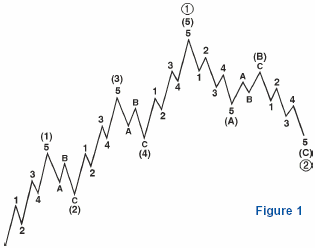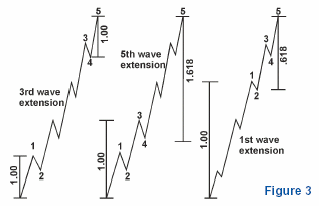Discovering How to Use the Elliott Wave
Principal
The Concept
When investors first discover the Wave
Principal, they're often most impressed by its
ability to predict where a market will head
next.
And it is impressive. But its real power
doesn't end there.
The Wave Principal also gives you a method
for identifying at what points a market is
most likely to turn. And that, in turn,
gives you guidance as to where you might enter
and exit positions for the highest probability
of success.
Step 1: Pattern Analysis
At its most basic level, wave analysis is
simply the identification of patterns in market
prices.
The idea that market prices are patterned was
intensely controversial just a few years ago.
But no longer. Recent discoveries have confirmed
that patterns exist in many natural systems even
systems that previously appeared to be random.
Examples include the weather, botany,
geography and even human physiology.
Generally, these systems unfold in patterns
of "punctuated growth" that is, periods of
alternating growth and non-growth, or even
decline. The patterns then build on themselves
to form similar designs at a larger size, and
then the next size up, and so on.
This emerging science is called "fractal
geometry." It is one of the mast exciting
branches of Chaos Theory. And it is precisely
the model identified by R.N. Elliott some 60
years ago in the financial markets.
The Basic Pattern
Elliott's pattern consists of "impulsive
waves" and "corrective waves." An impulsive wave
is composed of five subwaves It moves in the
same direction as the trend of the next larger
size. A corrective wave is divided into three
subwaves. It moves against the trend of the next
larger size.
As Figure 1 shows, these basic patterns build
to form five-and three-wave structures of
increasingly larger size (larger "degree," as
Elliott said).

In the above illustration, waves 1, 2, 2, 4
and 5 together complete a larger impulsive
sequence, labeled wave (1). The impulsive
structure of wave (1) tells us that the movement
at the next larger degree of trend is also
upward. It also warns us to expect a three-wave
correction — in this case, a downtrend. That
correction, wave (2), is followed by waves (3),
(4) and (5) to complete an impulsive sequence of
the next larger degree, labeled as wave 1. At
that point, again, a three-wave correction of
the same degree occurs, labeled as wave 2.
Note that regardless of the size of the wave,
each wave one peak leads to the same result a
wave two correction.
Within a corrective wave, subwaves A and C
are usually smaller-degree impulsive waves.
This means they too move in the same direction
as the next larger trend. (In Figure 2 below,
waves A and C are in the same direction as the
larger wave (2).) Note that because they are
impulsive, they themselves are made up of
five subwaves. Waves labeled with a B,
however, are corrective waves; they move
in opposition to the trend of the next
larger degree (in this case, they move upward
against the downtrend). These corrective
waves are themselves made up of three
subwaves.
Step 2: Trends and Turns
The analyst's first task is to look at charts
of market action and identify any completed
five-wave and three-wave structures. Only then
can he interpret where the market is and where
it's likely to go.
Say we're studying a market that has reached
the point shown in Figure 2. So far we've seen a
five-wave move up, followed by a three-wave move
down.
But this is not the only possible
interpretation. It is also possible that wave
(2) hasn't ended yet it could develop into a
more complex three-wave structure before wave
(3) gets underway. Another possibility is that
the waves labeled (1) and (2) are actually waves
(A) and (B) of a developing three-wave upward
correction within a larger impulsive
downtrend, as shown in the "Alternate"
interpretation at the bottom of the chart
According to each of these interpretations
though, the next imminent movement is likely to
be upward.
This illustrates an important point
concerning the Wave Principal. It does not
provide certainty about any one market
outcome. Instead, it gives you an objective
means of determining the probability of a
future direction for the market. At any time,
two or more valid wave interpretations usually
exist. So it's important for the investor to
carefully assess the probability of each
interpretation.
View the Wave Principal as your road map to
the market and your investment idea as a trip.
You start the trip with a specific plan in mind,
but conditions along the way may force you to
alter your course. Alternate counts are simply
side roads that sometimes end up being the best
path.
Elliott's highly specific rules keep the
number of valid interpretations to a minimum.
The analyst usually considers as "preferred" the
one that satisfies the largest number of
guidelines. The top "alternate" is the one that
satisfies the next largest number of guidelines,
and so on.
Alternates are an essential part of using the
Wave Principal. They are not "bad" or "rejected"
wave interpretations. Rather, they are valid
interpretations that are given lower
probability while the count works itself
out. If the market doesn't follow the original
preferred scenario, the top alternate usually
becomes the preferred.
Elliott's rules give specific "make-or-break"
levels for a given interpretation. In Figure 2,
for example, if the move labeled wave (2)
continues below the level of the beginning of
wave (1), then the originally preferred
interpretation would be instantly invalidated.
By eliminating subjectivity, the rules help
you firm up your investment strategy and reduce
your risk.
Fibonacci Relationships
Fibonacci ratios are named for the famous
13th-century mathematician Leonardo Fibonacci of
Pisa, the most important mathematician of the
Middle Ages. Fibonacci popularized the current
decimal and Hindu-Arabic numbering systems. He
also discovered (actually rediscovered) the
numeric sequence that bears his name, the
Fibonacci sequence which begins with the number
1 and in which each subsequent number is the sum
of the previous two: 1. 1, 2, 3, 5, 3, 13, 21,
34, 55, 89 and so on. The sequence in turn gives
rise to several unique ratios, including .618,
.382 and 1.61S — the Golden Ratio. These ratios
exist throughout nature, in everything from
population growth to the physical structure
within the human brain, the DNA helix, many
plants and even the cosmos itself.
Many investors today know that Fibonacci
ratios are used for market forecasting. But few
realize that Fibonacci analysis of the markets
was pioneered by R.N. Elliott. The use of
Fibonacci ratios requires a valid Elliott wave
interpretation as a starting point.
Unfortunately, many non-Elliott analysts try to
find Fibonacci proportions between market moves
that are not related to each other in any way.
This has made the approach appear far less
valuable than it is.

Elliott had two chief insights concerning
Fibonacci relationships within waves. First,
corrective waves tend to retrace prior impulse
waves of the same degree in Fibonacci
proportion. For example, wave (2) in Figure 2
retraces 38% of wave (1). That's a common
relationship. Other frequent wave relationships
are 50% and 62%. Second, impulse waves of the
same degree within a larger impulse sequence
tend to be related to one another in Fibonacci
proportion. (See Figure 3.)
Establishing Investment Strategies And
Reducing Risk
Wave interpretation rules and Fibonacci
relationships together are powerful tools for
establishing investment strategies and reducing
risk exposure. Investors use them to help decide
where to get in, where to get out and at what
point to give up on a strategy. Thus, the Wave
Principal lets you identify the
highest-probability direction for the market,
plus adopt an optimum position to take advantage
of it all while protecting yourself against
lower-probability outcomes.
Figure 4 shows a real-life example of a
market that has reached a point like that shown
in Figure 2. The lowest point on the chart is
the end of a fairly large-degree decline. Thus,
the investor would look for at least a
three-wave move to the upside at the same
degree.
In this case, the market has moved up in five
waves in about two weeks, with a three-wave
downward correction afterward, as in the
movement shown in Figure 2.
Once wave 1 to the upside is complete, the
investor can set price targets for wave 2. In a
given five-wave impulse sequence, wave 2 most
often retraces 62% of the preceding wave 1; next
most common are 38% or 50% retracements. These
relationships generate targets of approximately
5300, 5500 and 5400 for the bottom of wave 2, in
order of probability.
So if prices drop substantially below the 62%
retracement point at about 5300, probability
shifts away from the preferred interpretation.
And if prices fall all the way beyond the low
just under 5000, this development will violate
the rule that second waves may not retrace more
than 100% of first waves. This will require the
investor to shift to an alternate
interpretation, if he or she has not already
done so.
The investor can take advantage of these
rules and relationships in various ways. For
example, a longer-term investor might see an
opportunity near 5000. He would look to benefit
from the entire expected upmove, ignoring
interim corrections. Also, knowing that wave 2
cannot more than fully retrace wave 1, he could
determine that his interpretation would be wrong
if the market were to dip below the low. He
could choose to limit his risk there. Or,
because he knows that it is unusual for wave 2
to significantly exceed a 62% retracement of
wave 1, he might limit his risk at that level
and thus ahead of other sellers.
A shorter-term investor has a different
opportunity. He might look to take advantage of
each of the subwaves in the impulsive move up.
For example, after noting the end of wave 1,
he'd view a 38% retracement as the most likely
minimum downside potential for wave 2. He
would invest accordingly. Then he would watch
for an acceptable a-b-c pattern to signal a
reversal. When he saw it, he would look to catch
the expected wave 3 uptrend, and so on.
As Figure 4 shows, wave 2 displays a
three-wave, a-b-c structure. That structure can
be interpreted as complete at about 5275,
fractionally below the ideal 5300 retracement
level. This outcome increases confidence in the
preferred interpretation.
Figure 5 shows subsequent market action on a
zoomed-in, shorter-term chart. The market
reversed sharply higher from the wave 2 low,
displaying clear impulsive action. Thus, the
investor can look forward with confidence to a
move well above the top of wave 1 at about 5800.
He will check his strategy again at that point
and watch for signs of a reversal. He is of
course continually monitoring the market for
signs that his road map is keeping him on the
right path.
By the way, we've chosen an exotic market as
our example to prove a point. Elliott counts
work not only in commonly traded indexes and
stocks, but also in any freely traded market |